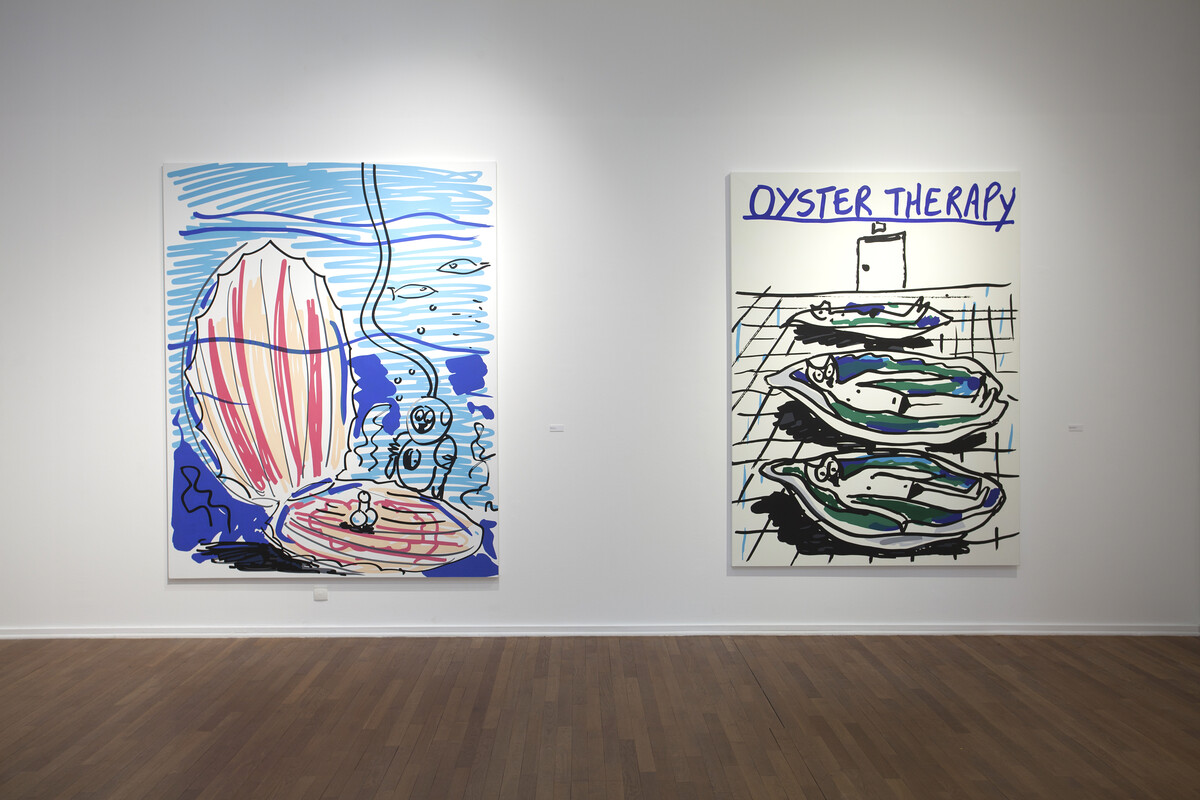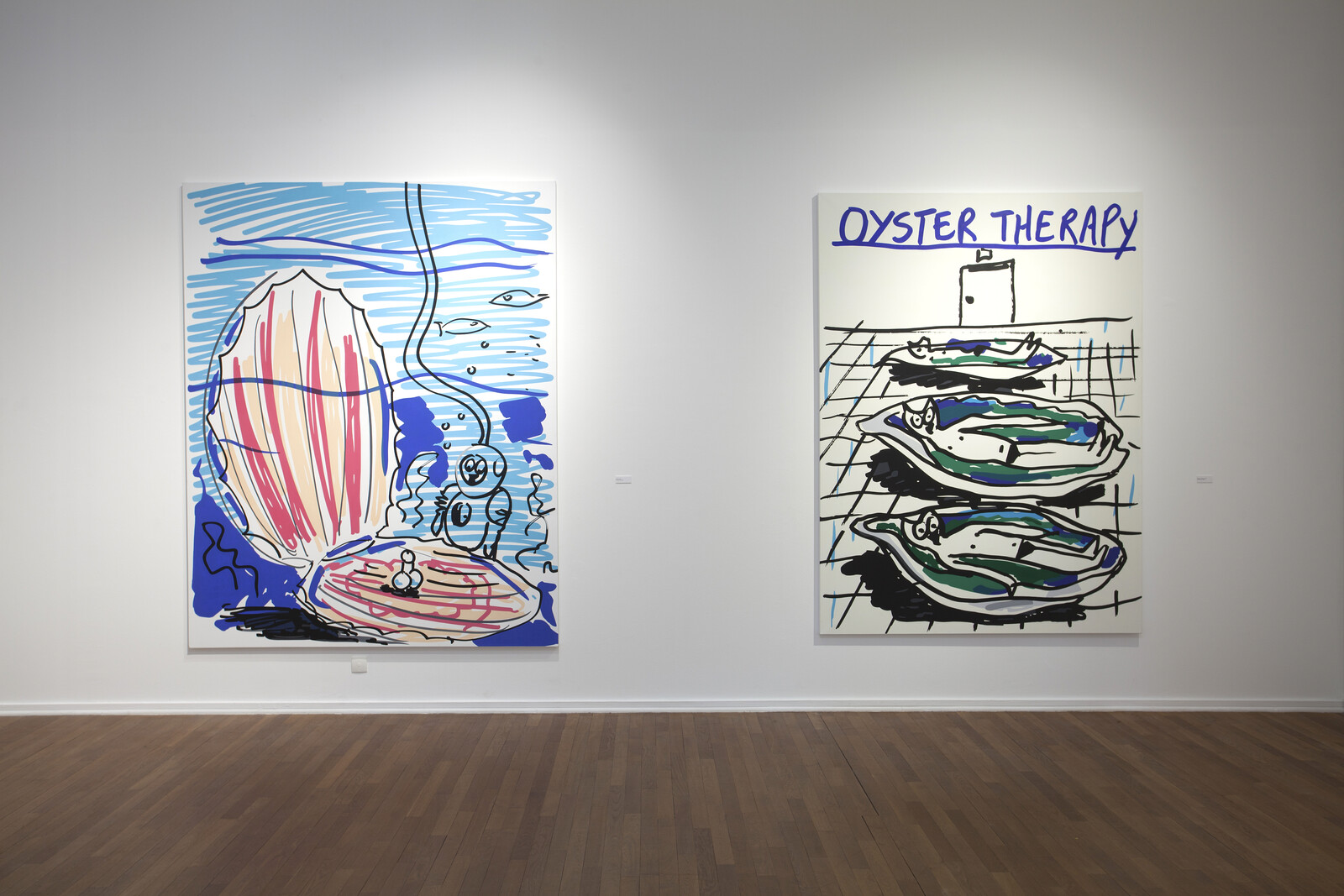Once a month, art-agenda and TextWork, editorial platform of the Ricard Foundation, jointly publish a Meta text. Here, Orit Gat reflects on her monographic essay on Alain Séchas’s work, “Vacances.”
Essays have invisible bibliographies. The books that are on your desk when writing. The books you reach to because something you looked at or thought about reminds you of something you once read. Books in which you find something new through writing.
I remember what I was reading when I was in France last July. I took the train from London to meet Alain Séchas in Paris. We then took a train together to see his exhibition, “Passe-temps,” at the Musée de l’Abbaye Sainte-Croix in Sables d’Olonnes. On both train rides, I read the same book, Annie Ernaux’s The Years (2008). It was just published in English. Somehow, I had never heard of Ernaux until that summer. (This is not true: in December, I found a copy of La Place, for which she won the Prix Renaudot, at my parents’ house. The price is in francs. I must have bought it as a teenager and forgotten it on a visit more than a decade ago.) But it seemed fitting to read on a trip to France. Ernaux, a memoirist who has written about her childhood, her family, every aspect of her life, writes in The Years about its whole span. The story of one woman in France between 1941 and 2006, The Years reads like the story of a society, a time, a place.
I was gone by the time I started writing about Séchas’s work. I was in New York, and it was August. I was listening to recordings I made talking to Séchas in his studio and in the exhibition halls at Sables d’Olonnes. I felt far: from my voice speaking hesitant French, from the Mediterranean scenery by the museum in a beach town in western France, which complemented the paintings so well. Writing about Séchas’s beach scenes, I looked for one line I remembered from Marilynne Robinson’s novel Gilead (2004): “The summer is ended and still we were not saved.” I never used it. Instead, I wrote about something from those audio recordings, a moment in which Séchas talked about other human beings in the simplest of terms: fascination. Séchas paints humanoid figures with cat faces. When I asked if he liked cats, there was a brief second where Séchas seemed confused by the question. Then he talked about ancient Egyptians worshipping feline deities.
When I was back at my desk in New York, the summer hadn’t ended yet. I felt like the only person working, so I wrote about vacation and tried to give the piece the texture of the season—blue skies, yellow sand, the cement and chlorine of public swimming pools, lunches on my fire escape, the metallic scent of air-conditioned subway cars. I was writing about my daily life, about a day’s work. How to write about an artist whose work I didn’t know well, then spent days alongside. I wrote about the studio: how tidy it was, hidden in a courtyard in a residential building in Southern Paris. I wrote about the paintings leaning against walls, halfway done, as if in repose from the labor of being made. A day’s work, again: going to the studio every day and finding something there. There, in the same materials or the same subjects. When I pressed on the cat faces, Séchas told me he was interested in the banality, the sameness of repetition. I wondered what it meant, to work through the same metaphor time and again. I now see it isn’t different from my bookcases: approaching the same books time and again, hoping to find something new.
I wrote a first draft of this essay over the winter holidays, in a sweaty hometown where Christmas is a regular workday, as are Sundays. I dipped my feet in the Mediterranean in December. Now, it’s May, and again, I’m far from my home. From a library, I think of my bookshelf at home, and how the shelf by my desk naturally became the way out of problems in writing: the place where I turn if stuck, if looking for a reference, if needing dialogue. It’s home to the books that inspired me, the books I aspire to. And it was built over time, with every essay requiring a walk along the shelves, looking for a line, a thought, a method, and every book remaining there, on that one shelf, part of a different story.
Looking back at the notes I took in the days I spent with Séchas, I see, for the first time, how influenced it all was by Ernaux. Ernaux who can describe a divorce by looking at a washing machine. (It shifts, you see: when purchased, it’s a symbol of a life, the promise of a home. It then loses all value, becomes a part of the days. When separating, the washing machine becomes a consumer good again, one that has a value that needs to be assessed and divided.) Reading Ernaux, I thought about objects, histories, how stories are told, how they are remembered. Looking at Séchas, I was thinking about quotidian subjects and the way the force of the everyday always comes through, even when at a distance, like a cat as a stand-in for a human. I’m writing and revising from across time and place, bringing together different people just as Ernaux writes in The Years using on, a French pronoun that doesn’t translate into English. A collective, “we” that also stands for “one.” Thinking of a memoir I read months ago, which rests on a shelf an ocean away.
I always wondered what it means if everything reminds me of what I read in books. Looking back at a summer from the edge of summer: away from my desk, my books, like Ernaux, I write from and about memory. I reread my old essay, I reread notes from books, I try to find a way into something I already knew.

